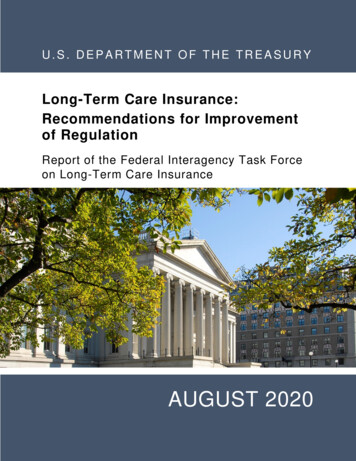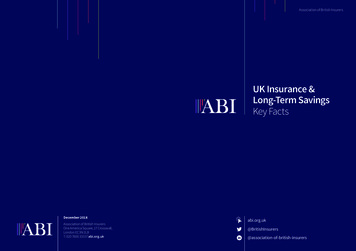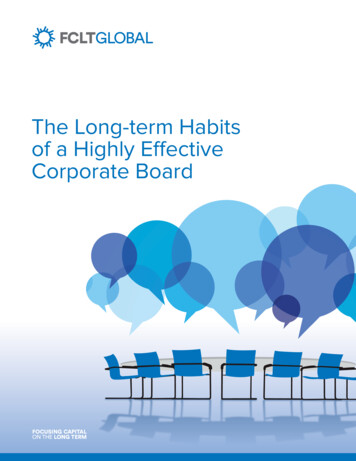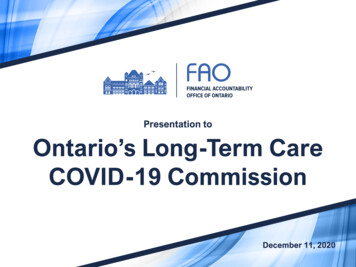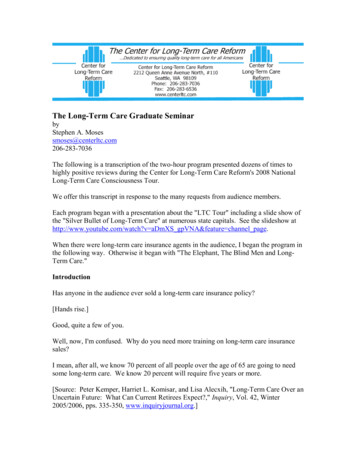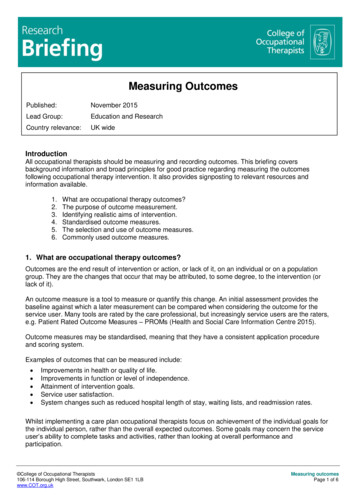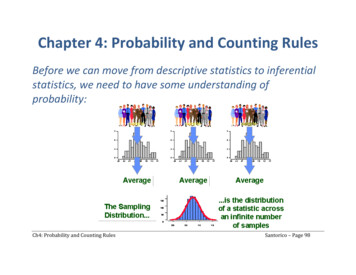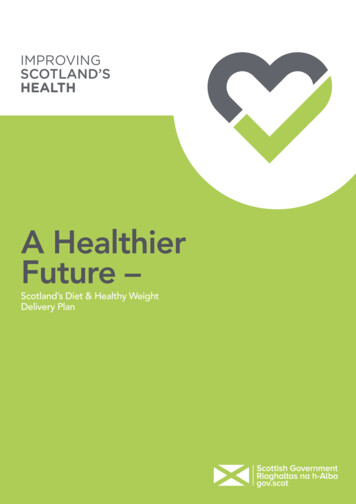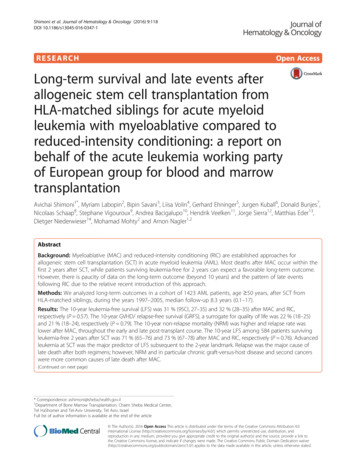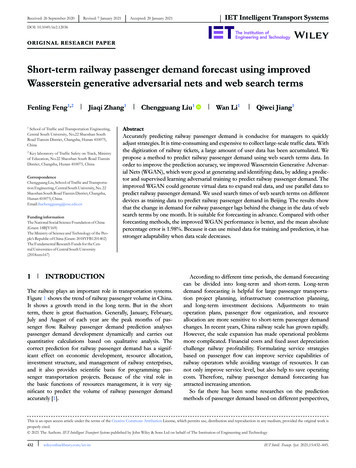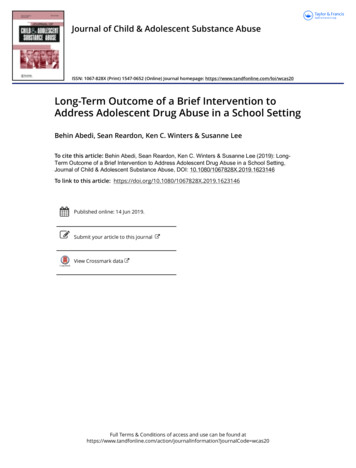
Transcription
Journal of Child & Adolescent Substance AbuseISSN: 1067-828X (Print) 1547-0652 (Online) Journal homepage: https://www.tandfonline.com/loi/wcas20Long-Term Outcome of a Brief Intervention toAddress Adolescent Drug Abuse in a School SettingBehin Abedi, Sean Reardon, Ken C. Winters & Susanne LeeTo cite this article: Behin Abedi, Sean Reardon, Ken C. Winters & Susanne Lee (2019): LongTerm Outcome of a Brief Intervention to Address Adolescent Drug Abuse in a School Setting,Journal of Child & Adolescent Substance Abuse, DOI: 10.1080/1067828X.2019.1623146To link to this article: shed online: 14 Jun 2019.Submit your article to this journalView Crossmark dataFull Terms & Conditions of access and use can be found ation?journalCode wcas20
JOURNAL OF CHILD & ADOLESCENT SUBSTANCE Long-Term Outcome of a Brief Intervention to Address Adolescent Drug Abusein a School SettingBehin Abedia, Sean Reardona, Ken C. Wintersb, and Susanne LeebaArgosy University Twin Cities College of Psychology and Behavioral Sciences, Eagan, MN, USA; bUniversity of Minnesota, Minneapolis,MN, USAKEYWORDSABSTRACTThe present study used data from a randomized controlled trial on brief interventions with adolescents to identify distinct longitudinal patterns of substance use and identify predictors, as well asoutcomes associated with those use patterns. Data were originally collected for the purpose ofevaluating two brief intervention conditions with adolescents who had been identified in a schoolsetting as abusing alcohol or other drugs (total sample, N ¼ 315). Adolescents were randomlyassigned to a two-session adolescent-only brief intervention (BI-A), a two-session adolescent-plusan additional parent session (BI-AP), or an assessment-only control session (CON). We located 74participants to assess them at approximately 3.5 years post-intervention. Three distinct cluster patterns were identified, including a low decreasing, moderate increasing, and high decreasing pattern of use. The low decreasing cluster was associated with the BI-A condition, mono-substanceuse, and comorbid anxiety symptoms at baseline. The moderate increasing cluster was associatedwith the BI-AP condition, polysubstance use, and comorbid conduct disorder symptoms at baseline. No variables were found to be predictive of membership within the high decreasing cluster.There were also no differences found between clusters on adjustment outcomes in young adulthood. Overall findings from this study support the long-term efficacy of a brief intervention, without parent involvement, for adolescents experiencing mild to moderate substance abuseproblems. Findings also highlight the importance of early intervention and the tailoring of interventions to meet the unique needs of adolescents.IntroductionAdolescent substance use continues as one of the most serious health problems in the United States (Feinstein,Richter, & Foster, 2012). The use of alcohol and other drugsduring adolescence interferes with normative developmentalprocesses and increases risk for a host of adverse consequences, including substance use disorders, academic difficulties,physical, emotional, and mental health-related problems, aswell as delinquency or involvement with the law (Brook,Stimmel, Zhang, & Brook, 2008; Englund et al., 2013).Moreover, the younger an individual is when he or shebegins using drugs, the greater the risk of developing a substance use disorder later in adolescence and in later stagesof life (e.g., Anthony & Petronis, 1995; Winters & Lee,2008). Efforts have been made to address adolescent druginvolvement before problems progress or increase in severity, and brief interventions are such an approach that havereceived widespread empirical attention (Marlatt &Witkiewitz, 2002; Monti, Colby, & O’Leary, 2001). Unlikemore traditional programs, which are based on an abstinence model of treatment, brief interventions typically take aharm or risk reduction approach by recognizing thatadolescent; briefintervention; long-termoutcome; substance abusereducing drug use and avoiding use in risky situations areviable goals. Whereas abstinence may be the end result ofan intervention, it is not considered necessary or essentialfor a successful intervention outcome.At a general level, brief interventions are appealing inthat they are brief (one to five sessions), cost-effective, canbe easily taught to service providers, and delivered across awide range of settings (Winters, 2016). Their attractivenessfor adolescents is enhanced in that techniques and strategieswithin extant interventions have routinely been constructedaround a developmental perspective and take into consideration factors such as adolescents’ reactance to authority, susceptibility to peer influence and the use of addictivesubstances, as well as general likelihood of using alcohol andother substances in young adulthood (Carney & Myers,2012; Monti et al., 2001; Winters, 2016).Several reviews of the literature have concluded that briefinterventions are effective in reducing substance use (Carney& Myers, 2012; Jensen et al., 2011; Tanner-Smith & Lipsey,2015; Winters, 2016) and preventing or redirecting potentially hazardous drug use trajectories (Monti et al., 2001).Also, brief interventions have shown to be effective inreducing substance-related problems, such as alcohol-relatedCONTACT Behin Abedibehin.abedi@gmail.comArgosy University Twin Cities College of Psychology and Behavioral Sciences, 1080a La Avenida St.,Mountain View, CA 94043.Color versions of one or more of the figures in the article can be found online at www.tandfonline.com/wcas.ß 2019 Taylor & Francis Group, LLC
2B. ABEDI ET AL.injuries (Tait & Hulse, 2003; Tanner-Smith & Lipsey, 2015).Also, the existing brief intervention literature lacks attentionon what variables moderate or mediate outcomes (Carney &Myers, 2012). Most extant brief intervention studies havefocused exclusively on outcomes in relation to substance useand substance-related problems (Carney & Myers, 2012;Tanner-Smith & Lipsey, 2015). A more thorough understanding of what impacts outcomes will help the field tomature (e.g., provide insights to improve the efficiency andefficacy of this model). Thus, the present analysis includedseveral predictor variables that have been consistently shownin the adolescent drug treatment outcome literature to belinked to long-term outcome (National Institute on DrugAbuse, 2014).Despite growing empirical support for the efficacy ofbrief interventions with adolescents, there continues to beseveral unanswered research, including the effects of briefinterventions when parents are involved, variables that moderate or mediate outcomes, and if positive outcomes are sustained over time (Carney & Myers, 2012). The present studyaimed to extend findings on brief interventions with adolescents by analyzing long-term outcome (approximately36 months) data from a longitudinal randomized controlledtrial that evaluated the use of two brief intervention conditions with adolescents. The research program involved evaluating these programs for adolescents who had beenidentified in a school setting as abusing alcohol or otherdrugs. Adolescents and their parents were randomlyassigned to receive either a two-session adolescent-only briefintervention, a two-session adolescent brief interventionwith an added parent session, or an assessment-only control condition.Each adolescent brief intervention session was characterized by motivational enhancement and cognitive-behavioraltherapy components; exercises for these components includethe decisional balance exercise, rating the readiness tochange ruler, and problem solving. The parent sessionfocused on strengthening parenting practices of support, discipline, and monitoring (see Winters, Fahnhorst, Botzet,Lee, & Lalone, 2012, for details). Data were gathered acrossfour assessment points, including baseline, six-, 12-, and 36month follow-up. At the six-month follow-up, adolescentsin the two brief intervention conditions showed significantlybetter outcomes than those in the assessment-only controlgroup, including lower levels of alcohol and cannabis use(days of use, abuse, and dependence symptoms), as well asdrug-related consequences (Winters et al., 2012). Differencesin outcomes were also observed between adolescents in thetwo brief intervention conditions. As indicated by Wintersand colleagues (2012), “the additional one session with theparent was associated with enhanced outcome effects compared to those youth who received just the two adolescentsessions” (p. 8).In a later publication on 12-month follow-up data,Winters, Lee, Botzet, Fahnhorst, and Nicholson (2014)found relatively similar results to findings at six-month follow-up, with participants in both the adolescent and parentcondition evidencing superior outcomes compared to thosein the assessment-only control group on cannabis use (usedays, abuse, and dependence symptoms) and other drugrelated consequences; no differences were observed in outcomes related to alcohol (use days, abuse, and dependencesymptoms). Unlike six-month follow-up findings, no differences were found in the substance use outcomes of adolescents in the two brief intervention conditions. Overallfindings provided support for the sustained positive effectsof the two brief intervention conditions on adolescent substance use.Using data from the randomized controlled study justdescribed, this study had three primary objectives. The firstobjective was to identify distinct homogenous patterns ofsubstance use over the 36-month follow-up period using acluster analysis procedure. Given the extant literature, wehypothesized that three distinct cluster patterns of individuals would be identified: (a) a group with an increasing pattern of use; (b) a group with a decreasing pattern of useover time; and (c) a third group with minimal use or abstinence. The second objective was to identify predictive factorsof these distinct cluster patterns of use. The primary predictor variable was the three-group condition that adolescents were assigned at the outset of the study (a two-sessionadolescent-only condition; a three-session condition with thesame two adolescent-only sessions and an additional parentonly session; or an assessment-only control condition). Itwas hypothesized that adolescents in the two active briefintervention conditions would reveal better drug use outcomes than youths in the assessment-only control group.Other predictor variables were baseline measures of age ofdrug use onset, polysubstance use, psychiatric comorbidity,and parenting practices. More specifically, it was hypothesized that earlier age of drug use, more polysubstance use,more comorbidity, and poorer parenting practices would beassociated with poorer outcome. The third objective was toidentify between-substance use cluster differences on psychosocial outcomes measured at the last follow-up point—for which there is extant research linking substance use andpsychosocial functioning (Center on Addiction andSubstance Abuse at Columbia University, 2011): educationalattainment, employment status, physical health, and legalinvolvement. It was hypothesized that lower levels of educational attainment, higher rates of unemployment, greaterphysical health problems, and more experience or involvement with law would be associated with poorer substanceuse outcomes.MethodParticipantsThe present secondary data analysis was based on longitudinal data collected by the Center for Adolescent SubstanceAbuse Research (CASAR) at the University of Minnesota,between October 2005 and September 2011. A detaileddescription of the primary study participants and proceduresis fully described elsewhere (Winters et al., 2012; Winterset al., 2014) and summarized here.
JOURNAL OF CHILD & ADOLESCENT SUBSTANCE ABUSEData were originally collected for the purpose of evaluating two brief intervention conditions with adolescents (ages13 to 19) who had been identified in a school setting asabusing alcohol or other drugs (Winters et al., 2012;Winters et al., 2014). A total of 315 subjects (N ¼ 315; males¼ 52%; females ¼ 48%) were included in the study, andmost (N ¼ 283) met Diagnostic and Statistical Manual ofMental Disorders (DSM-IV) criteria for an alcohol use disorder, cannabis use disorder, or both. Those (N ¼ 32) whodid not meet diagnostic criteria for a substance use disorderreported one or two symptoms of substance dependence.Subjects were randomly assigned to one of three conditions:a two-session adolescent-only brief intervention (BI-A); atwo-session adolescent, plus an additional parent sessionwith just the parent (BI-AP); or an assessment-only controlsession (CON). Data were collected using a comprehensiveassessment battery across four points or waves, includingbaseline (wave 1), six months (wave 2), 12 months (wave 3),and approximately three years (wave 4 or 36-month) postbaseline follow-up.And, of the 315 enrolled participants, 311 (99%) participated in at least wave 2 or wave 3 follow-up assessments,and 284 (90%) participated in both wave 2 and wave 3assessments. The outcome results of these data have alreadybeen published (Winters et al., 2012; Winters et al., 2014).The focus of this article is the participants for whom wave 2and 3 data were collected (N ¼ 284) and for those assessedat wave 4 (N ¼ 74; 23%). Characteristics of the study sampleincluded the following: average age at baseline and at wave4, 16.9 years (SD ¼ 1.1; 15–19) and 20.8 years (SD ¼ 1.4;18–25), respectively; 56% women; and racial/ethnicity breakdown as follows: White, non-Hispanic, 79.7%; AfricanAmerican, 6.8%; Hispanic, 6.8%; Native American, 2.7%;mixed race, 2.7%; and other, 1.4%. Intervention assignmentwas as follows: 32 in the adolescent-only BI group (BI-A;N ¼ 32 [43.2%]), 30 in the adolescent plus parent BI group(BI-AP; N ¼ 30 [40.5%]), and 12 in the assessment-only control group (CON; N ¼ 12 [16.2%]).Intervention groupsBoth intervention groups (BI-A and BI-AP) were organized around the existing adolescent brief intervention itive-behavioral therapy techniques (Monti et al.,1999). The parent session in the BI-AP group was basedon family therapy techniques (e.g., Liddle & Hogue,2001). The two identical sessions for BI-A and BI-APeach sought to gather information about the student’s history of substance use and related negative consequences;identify his or her stage of change; assess pros and consof substance use; teach the youth about triggers of substance use; enhance the youth’s skills to resist peer pressure and to make better decisions; and identify behavioraland attitudinal goals to promote health and well-beingincluding the reduction or halting of drug use. Session 3for BI-AP (just the parent) consisted of administering thesame motivational enhancement strategies to the primary3parent or guardian, with additional exercise aimed atimproving parenting practices.MeasuresOverview of measuring substance useSubstance use was assessed at each wave using the TimelineFollow-Back interview procedure (TLFB; Sobell & Sobell,1995). The TLFB has been found to be a reliable and validself-report measure of substance use frequency. Subjectswere asked at each assessment point to recall the number ofdays they had used alcohol, marijuana, and other illicit substances. At baseline, six-month, and 12-month follow-up,substance use was measured over the previous 90 days; at36-month follow-up, it was measured over the previousyear. For the purposes of the present study, all responseswere standardized (M ¼ 50, SD ¼ 10) to provide an equivalent metric of substance use from baseline to 36-month follow-up.Predictor variablesFive predictor variables—collected at baseline—were analyzed. All but two of these variables (i.e., group conditionand parenting practices) were assessed with the AdolescentDiagnostic Interview (ADI; age of drug use onset, polysubstance use, and psychiatric comorbidity; Winters & Henly,1993). The ADI is a structured interview designed to assessage of onset and history of drug use frequency (DUF),DSM-III-R and DSM-IV criteria for substance abuse anddependence, psychosocial stressors, and level of functioning,and screen for co-occurring behavioral disorders. The psychometric properties for these ADI sections are reportedelsewhere. Briefly, these ADI components are associatedwith favorable test-retest reliability and several tests of concurrent validity (see Winters, Botzet, Anderson,Bellehumeur, & Egan, 2001; Winters, Latimer, & Stinchfield,1999; Winters, Stinchfield, Fulkerson, & Henly, 1993).Group condition. The intervention condition that subjectswere randomly assigned at baseline was used as a predictorfor the change trajectories. As previously noted, there weretwo intervention conditions (BI-A and BI-AP) and anassessment-only condition (for description of the groups, seeWinters et al., 2012).Age of onset. Age of drug use onset was measured on theADI by one question that asked participants how old theywere when they first used alcohol, marijuana, or any otherillicit substance. For the present study, the earliest age ofonset was dichotomized to differentiate between participantswho first used substances at or prior to the age of 15 andthose who first used at age 16 or older.Polysubstance use. Baseline ADI responses were recodedinto a dichotomous variable, with yes (polysubstance use) orno (monosubstance use) categorization, delineating subjectswho reported using multiple or only one category of
4B. ABEDI ET AL.substances (alcohol, marijuana, or other illicit drugs)at baseline.vocational-tech certificate or degree; four-year degree; graduate degree).Co-occurring disorders. Based on screening items from thebaseline ADI responses, the probable presence of these fiveco-occurring disorders was assessed: (a) depression, (b)mania, (c) attention deficit hyperactivity disorder (ADHD),(d) anxiety, and (e) conduct disorder. Subjects were asked torate symptoms for each of the psychiatric disorders in a yesor-no format. Responses to each disorder were summed(yes ¼ 1; no ¼ 0) to create five distinct interval-level variablemeasures of comorbidity (i.e., depression, mania, ADHD,anxiety, and conduct disorder). Total scores for each diagnostic category measure ranged from 0 to 6. This domainwas also analyzed as an aggregate, interval-level variable, bysumming scores on the five disorders previously listed, withthe highest possible score being 30.Employment status. Subjects were asked to mark theiremployment status from a list of seven categories for mostor all of the period since they were last interviewed. Theseven categories of responses were collapsed into three,including (a) unemployed; (b) part-time (student, work forpay, homemaker); and (c) full-time (student, work for pay,homemaker) employment. Subjects who marked more thanone category of responses were classified under the categorywith the highest employment status, with responses rangingfrom low (unemployed) to high (full-time). Two part-timestatus responses were classified under full-time.Parenting practices. All subjects were administered anabbreviated version of the child Alabama ParentingQuestionnaire (APQ) at baseline (Elgar, Waschbusch,Dadds, & Sigvaldason, 2007; Shelton, Frick, & Wootton,1996). Relative to the original 42-item, five-subscale questionnaire, the abbreviated version includes 28 items andthree parenting subscales (parental monitoring, inconsistentdiscipline, and positive parenting). Subjects were asked torespond to items on a Likert scale ranging from 1 (not atall) to 3 (more than a little) based on interactions andexperience with their parents over the previous six months.The 28-item responses were summed to create one composite interval-level variable as a measure of parenting practices.Three of the 28 items were reverse coded to allow for asummed total, ranging from 28 to 84, with higher scoresindicative of more positive forms of parenting. The composite score has been “characterized by a single factor (eigenvalue ¼ 6.3)” and found to be “associated with favorableinternal consistency (alpha ¼ .81)” (Winters et al., 2014,p. 466).Psychosocial outcome variablesFour psychosocial outcome variables were analyzed. Allwere drawn from data collected at the 36-month follow-uppoint, using the Young Adult Follow-Up Interview(YAFUI; Winters, Realmuto, & August, 2002). The YAFUIis a structured interview that has been adapted from theADI. As indicated by Winters and colleagues (2002), theYAFUI has been found to be associated with favorableinter-rater and test-retest reliability, as well as a wide rangeof validity data.Educational attainment. Subjects were asked to rank theirhighest level of education on a 9-point Likert score, rangingfrom 1 (less than high school degree) to 9 (graduate degree).Responses were collapsed into three categories, including (a)less than a high school degree; (b) high school graduation orgeneral equivalency diploma (GED); and (c) any postsecondary (some college; some vocational-tech; two-year degree;Physical health. Subjects were asked 11 yes-or-no questionsabout their physical health since the last time they wereinterviewed. Sample questions included: Did you have anykind of head injury or accident? Did you see a medical doctor at an outpatient clinic/office for an illness or injury?Were you hospitalized for a medical or physical problem?Responses were summed (yes ¼ 1; no ¼ 0) to create oneinterval-level variable as a measure of physical health, withscores ranging from 0 to 11.Legal involvement. Subjects were asked 15 yes-or-no questions about their involvement with the law since the date atwhich they were last interviewed. Sample questions included:Have you been arrested? Have you been charged or convicted of a felony? Have you had a DUI/DWI? Responseswere recoded into a dichotomous categorical variable withyes-or-no categorization, indicating whether the participantdid (yes ¼ 1) or did not have (no ¼ 0) any involvement withthe law since the date at which the person was lastinterviewed.Data analysisThe present secondary analysis was longitudinal in nature,using a mixed between- and within-subjects design, withtime as the repeated measures factor.Patterns of substance useThe SPSS TwoStep Cluster Analysis procedure (Norusis,2011) was used to identify longitudinal patterns of substanceuse from baseline to a 36-month follow-up. It was originallyanticipated that the longitudinal patterns would be determined using expectation-maximization (EM) algorithmmodel-based clustering (Nagin & Odgers, 2010). Afterexploring the data, it was found that assumptions about themeasurement scale for substance use frequency did not justify the EM approach, as frequency of use was not measuredin a uniform way across all four waves of the study. Themodel-based EM approach was not used and instead wasreplaced by a conceptually similar clustering approach—theTwoStep clustering procedure. The TwoStep approach“extends the model-based distance measure to situations
JOURNAL OF CHILD & ADOLESCENT SUBSTANCE ABUSEthat include both continuous and categorical variables”(SPSS, 2001, p. 2). An even more attractive feature of thisclustering technique is that SPSS automatically computes theideal number of clusters.The SPSS TwoStep clustering procedure begins by breaking the total sample into micro-clusters containing highlysimilar cases based on a model-based statistical criterion(SPSS, 2001). Next, it groups these micro-clusters together,one at a time, to form groups with a maximum of eightcases in each. The algorithm then calculates an initial estimate for the ideal number of clusters based on a goodnessof-fit measure, and refines this estimate by finding the greatest change in the distance between various model sizes. It isimportant to note that although the TwoStep clusteringapproach automatically extrapolates, or computes, the idealnumber of groups, this secondary researcher evaluated thecluster solution in light of previous findings within theresearch literature in order to ensure that the results represented meaningful strata.Predictor variablesThe second aim of this study was to identify predictors ofcluster group membership. While intervention conditionwas the primary variable of interest, four other predictorvariables were added in case the brief intervention wasfound to be insignificant. As such, the predictive values offive independent variables were analyzed for cluster membership, including (a) intervention condition (BI-A, BI-AP,CON), (b) polysubstance use, (c) age of drug use onset, (d)co-occurring disorders, and (e) parenting practices.To assess the predictive value of intervention condition,participants were divided into the original groups they wereassigned at baseline, which included three levels of betweengroup treatment factors: BI-A (adolescent only), BI-AP (adolescent þ parent), and CON (assessment-only control).Treatment, or intervention condition, was considered theindependent variable and substance use cluster was thedependent variable. Since both the independent and dependent variable were categorical, a chi-square test for independence was utilized.A chi-square test for independence was also performed toexamine the association, or predictive value, of polysubstanceuse (yes-or-no categorization) and age of drug use onset( 15 or 16)—two categorical variables, each with two factor levels. A one-way analysis of variance (ANOVA) wasused to assess the predictive value of co-occurring disordersand parenting practices. This approach compares means ofthree or more groups on one continuous level variable.Given the continuous nature of the co-occurring disorderand parenting practice scores, as well as the anticipatedthree-cluster solution, a one-way ANOVA was consideredthe most suitable statistical procedure to analyze the predictive value of these variables.Psychosocial outcome variablesThe third and final aim of this study was to assess groupdifferences on the four psychosocial outcomes at 36-month5follow-up. A chi-square test for independence was performed to analyze differences between the substance useclusters on educational attainment (high school degree; highschool degree or GED; any postsecondary), employment status (full-time; part-time; unemployed), and legal involvement(yes; no)—three categorical variables. A one-way ANOVAwas used to evaluate between cluster differences on physicalhealth—a continuous interval-level variable.Power and effect sizeStatistical power was analyzed using a general power analysissoftware program, known as G Power, to detect range ofpossible effect size for predictor and outcome variables(Faul, Erdfelder, Lang, & Buchner, 2007). The sample size of74, combined with a repeated measure with four timepoints, yielded an estimated statistical power of .88 (88%) todetect a medium effect size and .51 (51%) to capture a largeeffect size, as defined by the Cohen’s d statistic. The resultssuggested that the statistical power was most likely in theadequate range of detecting a meaningful effect size.Missing data considerationA listwise deletion approach was used to handle missingdata relating to item nonresponse. Listwise deletion, alsoknown as complete case analysis, excludes any case withmissing values from the analysis (Graham, 2009). In orderfor this approach to be used, the data must be determinedto be missing completely at random (MCAR). While it isdifficult to determine the exact reason for missing data, areview of data within the present analysis supported randomness of the missing values.ResultsPreliminary analysesStatistical tests on baseline variables were conducted toassess for attrition bias by comparing the sample of participants included within the present analysis (N ¼ 74) to thosenot included (N ¼ 241) due to attrition across one of thefour waves of the primary study. Results revealed statisticallysignificant between-group differences in baseline alcoholabuse, t(313) ¼ 1.972, p ¼ .049, and dependence symptoms,t(313) ¼ 2.306, p ¼ .022, with participants in the presentanalysis evidencing higher mean symptom counts of alcoholabuse (M ¼ 4.59, SD ¼ 3.37) and dependence (M ¼ 4.99,SD ¼ 3.54) than those not included within the present analysis (abuse, M ¼ 3.72, SD ¼ 3.32; dependence, M ¼ 3.87,SD ¼ 3.67). No significant between-group differences wereobserved on baseline symptoms for cannabis abuse, t(313) ¼.053, p ¼ .958, and dependence, t(313) ¼ .765, p ¼ .445.There was also no significant difference between groupsin relation to gender composition, X2(1, N ¼ 315) ¼ 1.338,p ¼ .247. There was a significant difference in age, t(313) ¼4.75, p ¼ .000, with participants in the present analysisbeing on average one grade level above, or older (M ¼ 11.32,
6B. ABEDI ET AL.SD ¼ .92), than those not included (M ¼ 10.44, SD ¼ 1.52).There was also a statistically significant difference observedin ethnicity (White versus other), with the present studysample including more participants from Caucasian/Whitebackgrounds than the sample of participants not includedwithin this secondary investigation, X2(1, N ¼ 315) ¼ 1.338,p ¼ .247.Patterns of substance useThe TwoStep cluster analysis procedure generated a threecluster solution, with a silhouette measure of cohesion andseparation of 0.4; this measure suggested that the three-cluster solution was a fair-to-good estimate of the data structure(Norusis, 2011).The three substance use clusters, as depicted in Figure 1,evidenced distinct homogenous patterns of substance usefrom baseline to 36-month follow-up. Table 1 provides themean standardized substance use scores for each clusteracross the four waves. Cluster 1, labeled low decreasing, wascomprised of 29 participants (N ¼ 29) from the original totalsample of 74 (N
Long-Term Outcome of a Brief Intervention to Address Adolescent Drug Abuse in a School Setting Behin Abedia, Sean Reardona, Ken C. Wintersb, and Susanne Leeb aArgosy University Twin Cities College of Psychology and Behavioral Sciences, Eagan, MN, USA; bUniversity of Minnesota, Minneapolis, MN, USA ABSTRACT The present study used data from a randomized controlled trial on brief interventions .

